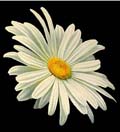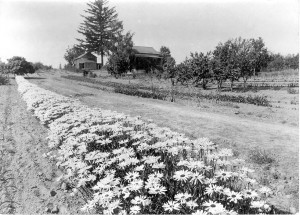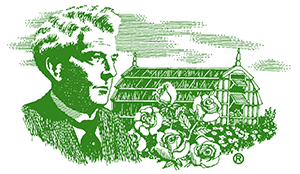 2001 marked the 100th anniversary of Luther Burbank’s introduction of the Shasta daisy, one of America’s most beloved garden flowers. Burbank spent 17 years developing this quadruple hybrid which he named after Mt. Shasta. Others have continued Burbank’s work and many new varieties of the Shasta daisy have been introduced since Burbank completed his work more than 100 years ago.
2001 marked the 100th anniversary of Luther Burbank’s introduction of the Shasta daisy, one of America’s most beloved garden flowers. Burbank spent 17 years developing this quadruple hybrid which he named after Mt. Shasta. Others have continued Burbank’s work and many new varieties of the Shasta daisy have been introduced since Burbank completed his work more than 100 years ago.
How Luther Burbank Made the Shasta Daisy
As a child in his native Massachusetts, Luther Burbank had a great fondness for the wild daisies that grew under the elm in front of his family home. These oxeye daisies had naturalized throughout New England, having been introduced accidentally from England by the Pilgrims. The young plant-breeder was inspired to develop these wildflowers for use as garden flowers, and envisioned an ideal daisy: it would have very large pure white flowers, smooth stems, early and persistent blooming, good keeping quality as a cut flower and sturdiness as a garden plant. The Shasta daisy is a quadruple hybrid.
In 1884, he planted seeds of the oxeye daisy (Leucanthemum vulgare) – which he had collected in New England – on the south side of his newly-acquired Santa Rosa property. He allowed the flowers to be freely pollinated by insects (open pollination) and selected seed from the best of these for replanting (selective breeding). He repeated this process for several seasons, but saw no significant improvement in the flowers.

He then pollinated the best of these early selections with pollen from the English field daisy (Leucanthemum maximum), which has larger flowers than the oxeye daisy. The seedlings from this cross (hybridization) were planted in Sebastopol at his Gold Ridge Farm, in rows 700 feet long. These new daisies flowered in their first year (instead of the second year, like their parents) and bloomed earlier in the season, with larger and more numerous flowers.
The best of these hybrids were then dusted with pollen from the Portuguese field daisy (Leucanthemum lacustre) and their seedlings were bred selectively for six years. More than a half million flowers were grown, to yield the few that met his standards. Eventually, daisies were developed that bore extremely large beautifully-formed blooms on sturdy, free-flowering plants. He considered them perfect, except that they weren’t white enough.
He pollinated the most promising of these triple hybrids with pollen from the Japanese field daisy (Nipponanthemum nipponicum), a species with small, pure white flowers. The first generation of what were now quadruple hybrids showed no change, but when he bred the new plants to each other (a Burbank innovation), the resultant seedlings bore flowers that were larger and beautifully white, on graceful, vigorous plants.
The new flowers were introduced in 1901 (17 years after the experiments were begun) as a mixed selection, the Shasta daisy hybrids. They were named for California’s glistening white Mount Shasta, and presented an entirely new plant species, now known officially as Leucanthemum x superbum.; Since that time, the daisy has become a popular icon as well as garden flower. Others have continued Burbank’s work, and many new varieties of the Shasta daisy have been introduced.
Where to find daisies
Luther Burbank Home & Gardens
The Gift Shop sells seed packets of Burbank’s ‘Alaska’. Plants are offered seasonally, or when available. Please call ahead for current availability: 707-524-5445.
Luther Burbank’s Gold Ridge Experiment Farm
At 7781 Bodega Ave, Sebastopol, CA, 707-829-6711. Holds plant sales of unusual varieties every Wednesday. This is the only source for ‘Chuck’s Delight’. They do NOT ship plants nationwide. www.wschsgrf.org
Local Nurseries
Shasta Daisy plants are normally available in California in late March.
King’s Nursery, 1212 13th St, Santa Rosa, 707-542-4782 www.kingsflowernursery.com
Emerisa Gardens, 555 Irwin Ln, Santa Rosa, 707-525-9644 www.emerisa.com
Mail Order Seeds
Swallowtail Garden Seeds, www.swallowtailgardenseeds.com, 707-538-3585, ‘Alaska’ and ‘Snow Lady’ seeds.
Mail Order Plants
White Flower Farm, 800-503-9624, www.whiteflowerfarm.com, ‘Becky’, ‘Snow Lady’, and ‘Christine Hageman’ available in March.
Jackson & Perkins, 877-322-2300, www.jacksonandperkins.com, ‘Little Princess’, ‘Aglaia’, available now.
Burpee, 800-888-1447, www.burpee.com, ‘Silver Princess’, ‘Alaska’, ‘Becky’, ‘Crazy Daisy’.
Dayton Nurseries, 330-825-3320, www.daytonnursery.com, ‘Alaska’, ‘Becky’, ‘Crazy Daisy’, ‘Little Princess’, ‘Snow Lady’, ‘Summer Snowball’, ‘Switzerland’, ‘Thomas Killen’.
Sugar Creek Gardens, 314-965-3070, www.sugarcreekgardens.com, ‘Becky’, ‘Crazy Daisy’, ‘Marconi’, ‘Polaris’, ‘Snow Cap’, ‘Snow Lady’, ‘Summer Snowball’. Find Shastas under “L” for Leucanthemum. Business opens March 1. Daisies ship after April 15.
